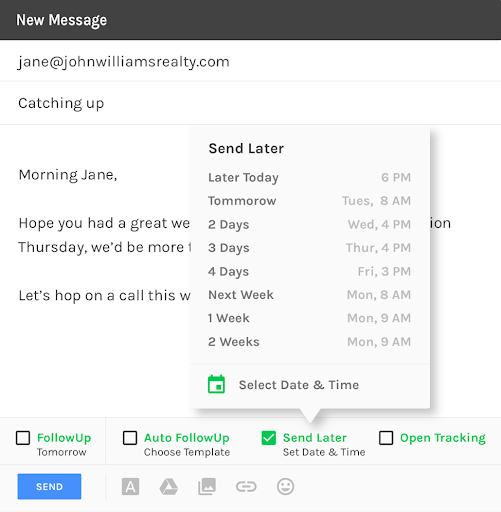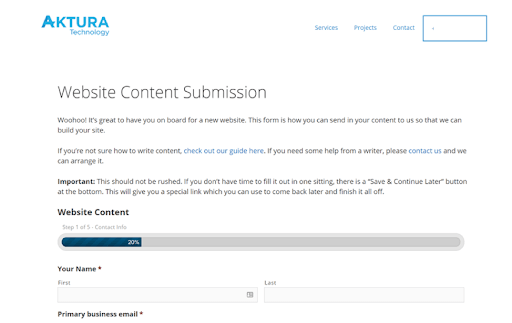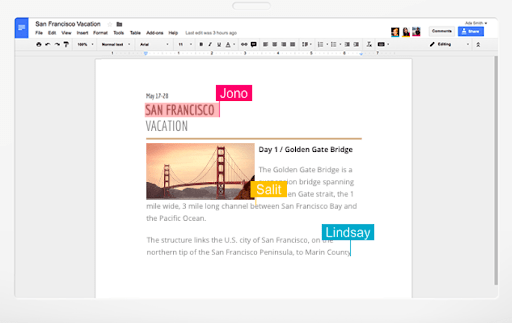

Updated December 16, 2024
Getting content from a new client can be a huge pain for web and graphic designers. Here’s how to implement a seamless content gathering process that will get you the information you need on time with minimal revisions.
Updated March 16, 2022
The content collection process is a huge roadblockfor many digital agencies, especially when it comes to websites. Sometimes projects are delayed by months waiting for the content you need to develop a website.
Looking for a Content Marketing agency?
Compare our list of top Content Marketing companies near you
By simplifying the process for clients, it reduces friction and helps you get what you need on time.
I’m the co-founder of Content Snare, a tool that helps digital agencies collect content from clients. Much of my time is spent working with agencies that are struggling with content collection to improve their process.
In that process, I’ve found commonalities among agencies that have eliminated this problem. In this post, I’ll discuss:
Looking for a content marketing agency? Check out our directory of top agencies.
Your clients are busy. It’s hard for them to find the time and patience to provide the content, even though you need it to do the work they’re paying you for.
Creating website content is time-consuming and difficult. So, of course, clients will put the task off, even if it’s in their own interests to do it quickly.
Email is the standard tool businesses use to communicate. Everyone has an email address and knows how to use it, so it makes sense to start with this medium.
However, collecting information by email can cause a lot of problems.
Corporate email users receive over 100 emails per day. Add time-consuming content emails to that, and they’ll likely just be ignored.
These worst problems, though, are the long email threads that build over time. They are difficult to sort through, and important details get lost.
When content elements are missed, you might end up creating a final product that doesn’t fit client expectations. Or worse, you might insist they didn’t provide those details in the first place, potentially sabotaging your relationship with the client.
In one example, a client sent a large email with content and included a small detail right at the end that changed the entire project. It was missed and cost the agency several days of time.
Then there are attachments. The free-form nature of email means people can attach whatever they want, no matter if it’s too large, too small, or just the wrong image.
Email may be the standard communication channel for online businesses, but it’s a risky option when client satisfaction is on the line.
Most clients don’t know exactly what’s needed. They have never created a website before, or they’re unsure about what content elements to include. You’ll know this problem exists when the content that does come back is vague or incomplete.
This creates serious challenges for designers. Projects grind to a halt, and it’s impossible to get any work done. Delays in projects also mean delays in getting paid.
On the other side, clients can get frustrated at the slow pace things are moving, even though we’re waiting on them.
Here are a few valuable strategies you can use to easily get content from your clients.
Your clients aren’t trying to put off sending content. They’re simply busy and forget. In order to keep things moving smoothly, you need to systematically remind them to provide the right information.
I recommend “time blocking” – setting aside an hour each week to check in with clients and remind them of what you need from them next. You can also use this time to provide project updates to give the client peace of mind.
We’ll also get into some automated email options below.
If there are multiple ways to provide content, things can get messy.
The most common is a combination of email, documents, and file uploads. This complicates the process for clients. It also wastes your own time to collate the content and make sure you have everything you need. Some agencies have an entire person dedicated to this process.
When you use a central content repository or a “single source of truth,” your clients know where they need to go to submit content, and it saves your agency countless hours of management.
Clients need guidance. If you provide them with clear instructions from the beginning, they’re much more likely to follow through and provide information quickly.
Create a standard of exactly what kind of content you need and what format it should be in, and show them right at the point they are providing content.
For example, the screenshot below shows the importance of a header. Other examples include copywriting instructions on how to write a good headline or call-to-action (CTA).

Images like this can clarify questions and streamline the process for your clients.
Provide visual references such as wireframes or mockups - like the above screenshot. Clients can’t visualize the final website as well as you can.
Show clients an example of what the content might look like in practice, and it’s much easier for them.
Taking it to the next level, you can even create videos that walk clients through the process. Making personalized videos only takes a couple of minutes with a tool such as Loom. Those couple of minutes will save you hours later.
You need to show clients what you need from them.
As with most aspects of an online business, tools and technologies can help you reach out to clients, gather content, and streamline your processes.
Below are a few tools I recommend.
Reminding clients is both time-consuming and a pain to do. If you automate your follow-up emails, you’ll never have to think about it.
When sending an email to request content, you can set up a series of spaced-out email follow-ups. If clients respond to your email, the follow-ups will automatically cancel.
There are lots of tools that can do this for you, such as FollowUpThen, Boomerang, and Followup.cc.

These tools will ensure you’re automatically following up with clients within a certain period of time – saving you time and effort to remember on your own.
Web forms are a great way to ensure you get all the information you need from a client the first time.
Create custom fields in your web forms asking clients to fill out important website information that you need, such as headers, services, “About Us” text, etc.

Web forms have a rigid structure, which is both good and bad.
The good thing is that they force users to provide exactly the information you’re asking for, nothing more, nothing less. The bad thing is that there’s no flexibility if your clients want to provide additional information or explanation beyond what you’re asking for.
Google Docs is an alternative to web forms that offers more flexibility.
Like with your web forms, create sections that your clients can fill in with website content. Break things down so they don’t skip over important details such as headings, subheadings, and calls-to-action.
Unlike web forms, clients can also fill out additional information if they want. This flexibility can pose a separate problem if clients get a bit too creative and start asking questions and adding instructions for you inside their content.

Another benefit of Google Docs is that it allows you to communicate back and forth with comments and suggestions for your clients. It also tracks version history so you can go back when needed.
For every problem in the digital world today, there’s a tool. Content Snare is designed specifically to help get content from clients.

This tool:
As a result, Content Snare is a simple and efficient way to communicate with clients and gather content.
If you’ve collected content from clients before, you’ll know that it’s a bottleneck that can grind projects to a halt. Creating a simple process for clients helps them provide content on time and in the right format with fewer revisions.
The key points of this post come from working with many agencies to improve their content collection process with Content Snare. The most successful agencies in this area:
It’s human nature to delay difficult tasks, so the easier you can make it for clients, the more likely it is to get your content back when you need it.
Looking for an agency to help bolster your content efforts? Check out our directory pages to find the right provider to fill your needs.
 James Rose is a co-founder of Content Snare and hosts the Agency Highway podcast. He has a passion for helping web designers and digital agencies do less work, get better clients and reduce their stress levels. This developed after several years of stressing too much in his agency.
James Rose is a co-founder of Content Snare and hosts the Agency Highway podcast. He has a passion for helping web designers and digital agencies do less work, get better clients and reduce their stress levels. This developed after several years of stressing too much in his agency.


